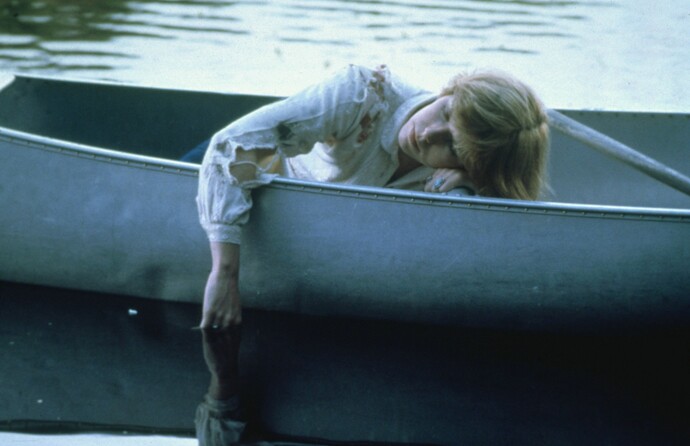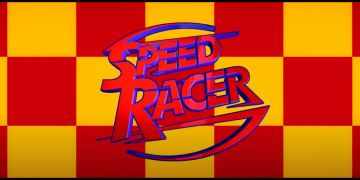We often recommend media and products we like. If you buy anything through links on our site, we may earn a commission.
Slasher movies make up one of the biggest subgenres in horror, with origins rooted in Italian giallo films of the 1960s and 1970s.
Not to be confused with splatter films—which focus heavily on graphic, gory violence—slashers tend to follow a murder (or several murders) carried out with some kind of bladed weapon.
It sounds weirdly specific, but there are actually a ton of slasher movies that mainly span across three cinematic eras:
- The Golden Age (1970s—1990s)
- The self-referential era (1990s—2000)
- The modern neo-slasher cycle (2000—present)
Here are our top picks for the best slasher horror flicks ever made, most of which come from the classical age of slashers.
Paramount+ offers thousands of movies and TV series to stream online, plus live news and live sports, starting at $5.99/mo. Check out Paramount+ now!
Sean S. Cunningham’s sleeper hit Friday the 13th was 1980’s most commercially successful slasher film, drawing in millions to theaters despite a slow start.
Like many horror movies of the time, Friday the 13th struggled to make noise in the wake of Halloween’s success. But once it managed to get on the map, boy, it made quite a racket!
Friday the 13th is interesting because it was the first independent film to be distributed by a major Hollywood studio (in this case, Paramount Pictures). This was due to the fact that slasher movies were in, so it was a pretty low-risk bet that it would turn a profit.
Friday the 13th centers on Camp Crystal Lake, at which a bunch of people were mysteriously killed in 1958. When the camp is reopened in 1979, the same thing happens again. The killer in question is Jason Voorhees… or so people think.
He’s the guy in the hockey mask you probably see every Halloween, who reappears in a string of sequels and slasher-crossovers.

Amazon Prime offers unlimited streaming for thousands of great TV shows and movies, plus 2-day delivery, free games and ebooks, and more. Try it for FREE for 30 days!
The only film on this list that came out after 2000, Candyman is a sequel to the 1992 original by Bernard Rose. The story was taken from Clive Barker’s six-part horror anthology called Books of Blood, released between 1984 and 1985.
Directors Nia DaCosta and Jordan Peele’s supernatural slasher was stuck in development hell for years before the studio agreed to make it. Yahya Abdul-Mateen II stars as a visual artist who’s obsessed with the legend of the “Candyman” and paints gradually darker portraits.
The ghostly, hook-handed figure supposedly haunts the Cabrini-Green housing projects in Chicago, putting razor blades in candy to give to kids. But it turns out that there’s a whole “Candyman Hive” of real-life victims to watch out for.

Christmas is a clever setting for all kinds of movies. The festive period is supposed to be a time of joy, family, and celebration. When things go bad, the colorful lights only emphasize the bitterness.
Bob Clark’s Canadian slasher Black Christmas does just that, turning “Silent Night” into “Evil Night” (as the film was originally titled).
The babysitter victim isn’t a new archetype in horror films, rooted in an urban legend from way back in the 1960s. This, in conjunction with the murder spree of William Patrick Fyfe in Montreal, was the inspiration behind Black Christmas.
The word “babysitter” might bring to mind John Carpenter’s Halloween, but that was actually made four years after Black Christmas and was influenced by this not-so-Christmas film.
Like a lot of slasher films—and even many horrors and thrillers—it all starts with some creepy phone calls. A group of sorority sisters are hounded by threatening calls, then stalking, then killing.
Black Christmas wasn’t an instant success, but has since been re-evaluated as one of the greatest slasher movies ever made.

The fact that the title contains “Chain Saw” and “Massacre” makes The Texas Chain Saw Massacre an obvious pick for this list. It’s a title that turns away everyone who’d hate this kind of movie, while reeling in hardcore horror fans.
The Texas Chain Saw Massacre features an unfortunate group of friends who run out of gas in the middle of nowhere.
What made Tobe Hooper’s grisly horror so controversial is also what got it banned in several countries: the only people around are Leatherface (who wears a mask out of human skin) and his cannibalistic family.

1960 not only marked the dawn of a new decade, but also the dawn of a new genre of horror.
Although Alfred Hitchcock is often credited with the creation of the slasher genre with his 1960 film Psycho, Peeping Tom was released five months prior and was arguably the true “first.”
Being a Peeping Tom is already gross, but we’re not just talking about climbing a tree and peering into a window. The homicidal, voyeuristic themes of Michael Powell’s British thriller are already Hitchcockian, but Mark does more than just secretly film girls—he kills them, too.
With a blade stuck to his tripod, Mark records the terrified expressions of his victims as they die. In fact, he films pretty much everything, pretending to be making a documentary but really just being a weirdo.

Patrick Bateman is unlike any character cinema has seen, perfectly portrayed by Christian Bale. He’s charming, well-groomed, wealthy, with a gorgeous fiancée. The only thing is, he’s a sociopath who kills for fun. Well, not really for fun as it’s more of a compulsion.
Set in the 1980s, American Psycho is one big jab at materialistic, New York yuppie culture. After sweating profusely at his co-worker’s business card, Patrick decides to get Paul (played by Jared Leto) drunk and then chop him up like bits of wood.
What’s remarkable is how casually Patrick carries out his murders. The way he’ll smile through a remark like “Did you know I’m utterly insane?” as if homicide were completely normal.
Patrick’s eerie mix of coolness and insanity is what makes him such a legendary anti-hero. He’s more concerned with clear skin and face masks than the pile of corpses in his closet, which have been mostly cut up with axes, chainsaws, and nail guns.

What’s most frightening (and effective) about A Nightmare on Elm Street is that the villain only appears in your dreams—and the injuries incurred show up in real-life, meaning death awaits every time you slumber.
Freddie Krueger is basically the ghost of a child-killer, his face still melted from being burned alive by their parents. In the dream (or nightmare) world, he’s a powerful force to be reckoned with, but he returns to a vulnerable, human state on Earth.
Freddie has appeared in tons of spin-offs (not all good) and has been played by various actors, but his debut was in Wes Craven’s supernatural slasher (which academics have read to have queer connotations that Craven denies intending).
Blending real with imaginary, A Nightmare on Elm Street was hailed for cultural significance and themes of morality and perception.

Teenage girl Casey (played by Drew Barrymore) receives an alarming phone call at the beginning of Scream, one which even references the film Friday the 13th.
The sadistic caller wears a black robe and ghostly mask, watching Casey from the window and asking her a trick question: “Who is the killer in Friday the 13th?” Obviously, she says Jason (a wrong answer) and that costs her boyfriend’s life.
Also directed by horror fanatic Wes Craven, Scream is satire that only follows the conventions of a slasher movie to poke fun at it. Yes, this means Craven is poking fun at his own previous work.
The group of teen friends, the phone calls, the masked killer—we’ve all seen it before, but Scream still manages to be an amazing film!
The self-aware aspect of Scream helped make it even more popular, and it was even called Scary Movie before it was bought by Dimension Films. Scream isn’t quite the comedy satire that the eventual Scary Movie ended up being, but it was credited with “revitalising” slashers.

Though not the first, Halloween is the most famous example of the babysitter slasher victim.
Portrayed by Jamie Lee Curtis, Laurie is unnerved by a man who stalks her all day. After brushing off Michael Myers (big mistake), he follows her into her babysitting house on Halloween night.
With a similar look to Jason Voorhees, Michael Myers wears a white mask and coveralls, knife raised in hand. What makes him even creepier is the fact he doesn’t speak; he’s a silent figure looming in the shadows.
As it turns out, Michael killed his teenage sister when he was just six-years-old and recently escaped a mental asylum.

Psycho is by far the least gruesome slasher movie on this list. We barely even see the blade that famously kills Marion in the shower!
So, why is it number one? Well, because it’s Psycho!
Unless you’ve been huddled under a rock, you’ve probably seen this film. You might’ve even studied it in school. Sure, by today’s standards it’s barely a horror movie, but back in the day, Psycho was a daring movie that railed against the censorship board.
Janet Leigh is the star of the film. Or, at least, she is for a bit because Alfred Hitchcock kills her off halfway through.
Viewers of the time would have been rocked by this plot twist, but we now know that changing the narrative halfway through and targeting blonde female victims were Hitchcock’s thing.
Norman Bates doesn’t boast a human face mask or a chainsaw, but he does wear his dead mother’s clothes while carrying a pocket knife. Less is more, and Norman Bates (famously played by Anthony Perkins) is certainly as scary as any Leatherface.
Source by whatnerd.com





























